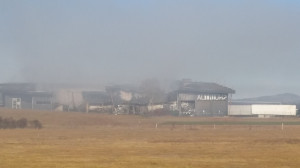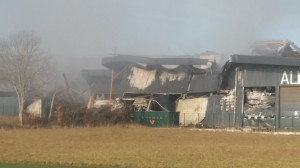At around 12:30 a.m., a fire broke out at a 10,000 m² sorting plant that was closed for the weekend. A local resident gave the alert. The metal skeleton of one building collapsed, bringing down its green roof with it. The 2-hour fire rated walls slowed the spread of the fire, but failed to prevent it travelling along the carpet and ventilation ducts. The fire, which was brought under control at 6:50 a.m., necessitated efforts by more than 100 firefighters. The firewater (400 m³) was collected in suitable ponds.
Extensive material damage
Most of the waste treatment building (5000 m²) was destroyed. The solid recovered fuel (SRF) production facility, compost sifting facility, and manual and mechanical sorting lines were damaged by the fire. Smoke continued to rise from the ruins for several days after. The entire production staff of 11 people were furloughed. In July 2018, the press reported that it cost €9 million to rebuild the site.
Malicious act?
The fire is believed to have started at various points in the building. The building was not protected by an intrusion detection system. In addition, the gendarmes had patrolled the area at 11:30 p.m. but did not notice anything out of the ordinary.
The inspection authorities for classified facilities asked the operator to test the soil for contamination from dust particles left by the fire (PAH, PCB, metals, phthalates, etc.). The tests had to be conducted at a minimum of three downwind points within a 300-m radius of the facilities. The firewater transferred to the retention ponds was tested (pH, BOD5, COD, etc.) and treated quickly to prevent the ponds overflowing in case of rain. Lastly, the operator was asked to take feedback of the fire into account when rebuilding the damaged buildings. The prefect issued an emergency-measures decree to manage the post-accident phase, including the disposal of waste from the fire and the transient conditions for allowing incoming waste.
Positive feedback
The fire-rated walls had adequately protected the waste delivery building from the fire. The same was true, albeit to a lesser extent, for the walls separating the SRF production floor from the mechanical and manual sorting lines. However, it was found that the fire-rated wall of the SRF building was beginning to collapse. Control of heat fluxes was evidenced by the absence of damage to the equipment located on the building’s outer edges.





